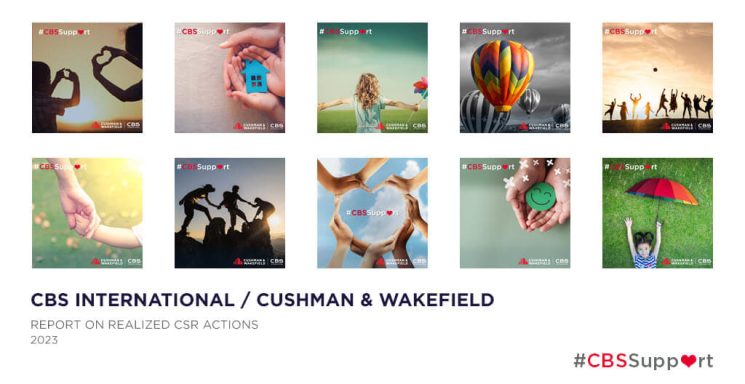
Which Trends Shape the Landscape of the Residential Market Today?
The dynamics of the residential real estate market are undergoing a transformative shift, shaped by the impact of global events. External factors, including the far-reaching impacts of the health crisis, geopolitical tensions and a global economic slowdown, have played a pivotal role in shaping certain trends. Simultaneously, the residential market itself has evolved, primarily by adopting modern trends in construction, structure and furnishing of living space.
1. Purchase of apartment becomes digital
Property search through social media and other digital platforms increased by 23% globally in the last 5 years. The pandemic has accelerated digitization in all segments and the real estate market is not an exception, and some buyers decided to buy real estate online, without entering the space. Thanks to digital capabilities, buyers were able to virtually tour properties using 3D renderings of apartments, drones and videos, as well as virtual tours of properties and their surroundings.
Brokers, such as real estate agencies and consulting companies, as well as investors, significantly improved the usage of digital platforms for buying apartments. The virtual property tour is not the only aspect of the digital purchase of the apartment. Investors as sellers and real estate agencies as brokers, offer an option to search the property through the application, as well as financial advisory services in terms of compiling offers from banks and searching for the most favorable option for credit buyers. Additionally, in more developed markets, banks and other financial institutions offer the option of obtaining a housing loan online, hence, in the last 5 years, such transactions have increased by 46% globally. Millennials, who rely on social media significantly, also turned to technology to decide on buying real estate, especially to get more information about the details of the project, as well as the property’s pros and cons. Namely, the residents of certain projects have groups on social networks, where you can find out a lot of useful information, some of which can be a decisive factor when buying a real estate, or giving up on it.
2. Reshaping Habits: The Shift to Suburban Living and the Rise of Digital Nomadism
Although the pandemic initiated a migration of the population to the outskirts, the trend of replacing living in the large city continued after the health crisis. This trend has been confirmed by a large number of luxury complexes being developed in suburban municipalities of Belgrade, such as Grocka, Sopot and Mladenovac, but also in other Serbian municipalities and cities such as Indjija, Irig, Beocin, Novi Sad, Sremski Karlovci, etc., which is proved by registered transactions of houses during 2023, according to the official sources.
The main reason for the growth of this tendency is primarily changes in the concept of work. According to our company’s research, a significant number of employees have returned to the office in 2023. Although the percentage of employees who work only remotely dropped below 10% in 2023, around 50% of companies in Belgrade kept the hybrid model of work. Employees who have the option to combine work from home and work from the office can opt to work in a quiet environment in nature.
Also, the number of digital nomads has increased. Namely, freelancers, who can work from home or any part of the world, were present before as well, however, changes in working trends led to a huge emergence of work from distant locations, often abroad destinations. The trend is so popular that some countries have changed the labour laws regarding the work and residence of foreigners, to attract foreign workers-digital nomads and make their stay in that country easier. In this way, the rental market is encouraged, while some hotels repurposed part of their accommodation capacity for digital nomads, especially in a period when hotels, due to restrictive measures, recorded negative trends in the number of arrivals and overnight stays. This concept enabled hotels and private accommodations to maintain occupancy of accommodation capacities even outside the high tourist season. In the region, good examples are Croatia and Montenegro, where in Zadar the Falkensteiner hotel chain opened the first village for digital nomads with 20 mobile homes and a coworking space for socialization, networking and meetings. Additional amenities provided to digital nomads are SPA, gym, restaurants and laundry service. The Government of Montenegro adopted the Program for Attracting Digital Nomads, which promotes Montenegro as an attractive destination for this type of worker, granting them a residency and defining tax benefits for the income they earn by working for foreign companies.
3. Residential complexes are the most desirable option for living
The residential market in Belgrade and Serbia is following the world’s trends in the development of residential projects. Namely, similar to more developed European capitals, Belgrade and all major cities in Serbia, witness the planned construction of large residential complexes, especially closed ones (condominiums) with numerous additional content necessary for the residents’ daily life. These contents include retail offers that meet the basic needs of tenants such as grocery shops, bakeries and pharmacies, retail units such as cafeterias and restaurants, hairdressers, and very often health services such as private polyclinics, dentists, etc. More luxurious complexes offer more luxurious amenities such as a reception and doorman, a spa zone within the complex with a swimming pool and gym, sports fields, parks and green areas with a children’s playground or outdoor gym exclusively for tenants. Also, the emphasis is on the security of the tenants, therefore, these projects always provide professional security and video surveillance, as well as controlled access to the complex. The aim is to provide future tenants with security, privacy, comfort and all the amenities they need for everyday life.
4. Postponement of independence impacts the rental market
In the previous period, we witnessed a strong expansion of the residential rental market, especially thanks to migrations of population and import of labor force. In addition to representatives of foreign companies, which opened their HQs in Belgrade and thanks to the importation of workers of deficit professions, the apartments’ tenants in Belgrade are also people living in other Serbian cities who move to the capital for study or employment. These are tenants who sign a lease for a certain period, while they are studying or working on a project, or for a mandate of diplomatic mission in our country.
When it comes to long-term rental options, where the rented apartment is used for living space for those who are not able to buy a property, the official data are very negative compared to the EU average. Namely, in the capital of Serbia, young people decide to become independent and live outside their parents’ home very late, even when they find their first job. Regarding the students, this practice is unknown, considering that the hourly wages for student jobs are low and students cannot afford to live separately during their studies. According to research done by Eurostat in 2021, young people in Serbia are 31 years old on average when they emancipate from their parents’ homes, which is significantly above the EU average since the young people in the EU leave their parents’ homes at the age of 26. The limited income for renting an apartment, as well as unstable student jobs, are the main obstacles to the emancipation of young people, who generally delay their decision to independent life until entering a cohabitation or marriage. For this reason, the largest share of the rental market makes employees and those who move to Belgrade and Serbia to work.
5. Green buildings in focus
At the moment, due to global warming, large pollution and the reduction of green areas due to mass urbanization, one of the “hot” topics in the construction sector is green buildings, a trend that is becoming more represented in Serbia, as well. Although 85% of buildings in Serbia are not energy efficient, since they were developed in the period between the 60s and 80s of the last century, changes in construction standards are visible, especially through the construction of energy-efficient buildings and residential complexes. An energy-efficient building consumes less energy, but in a more efficient way, without harming the feeling of comfort and working and living conditions of people, related to savings measures. This is achieved by good insulation of facades, replacement of doors and windows on buildings of older construction, better insulation of roofs and structures between floors, installation of solar panels on roofs, as well as the use of raw materials and materials in construction, which are quickly renewed. In this way, the consumption of energy for heating and cooling is reduced and it contributes to the protection of the environment by reducing the emission of dangerous gases. Higher consumption of heating energy not only affects the environment and air pollution, but also represents a financial burden for the households. Additionally, an increasing number of residential projects are implementing the smart-house system, which enables the control of energy sources and their consumption even when we are not in our apartments.








